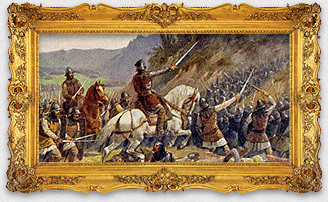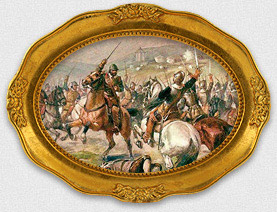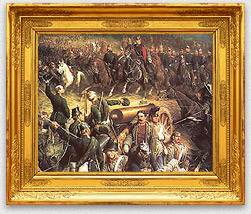


In year 1055 prince Břetislav I implemented a new Order of Succession, so called agnatic seniority. According to this order the reign in Bohemia should be passed on the oldest male member of the Přemyslid Dynasty. For younger members there were conferred principalities founded in Moravia.
The Order of Succession of the agnatic seniority did not prove useful for a longer time and was broken several times. In one of these cases when the order was broken, it was the ascension of Soběslav I ...

The 13th century presented in the history of Western and Central Europe a period of a relatively fast economic development which was accompanied by a population growth. As a consequence of the German colonization, feudalization and spreading of the Western culture it came, among others, to closer links between the area of Central Eastern Europe and the Western European cultural area.
Unlike Poland and the Kingdom of Hungary, the Bohemian Lands were not later strongly affected by Tatar invasions...

A rather fast development of society, economy and culture in Western and Central Europe in the time of the High Middle Age, i.e. from the 11th to the mid-14th century changed to a crisis which started in the mid-14 century. The pillars which till that point built a stable basis for the middle-age feudal society started to tremble.
There were plague epidemics (the biggest one was in the mid-14th century) which martyred the people...

The second half of the 14th century in Europe of that time was marked by deep crisis in economy and society. In years 1378 – 1417 the crisis was even stronger because of the papal schism, a situation in which there were two or even three appointed popes fighting for the leadership of the church.
This situation led to several attempts to reform the church, or more precisely the whole feudal society. The most successful of them was the Hussite movement which ushered far wider turbulence which followed as German reformation a hundred years later...

The Hussite revolution, which in years 1419 – 1434/36 ran through Bohemia and partially also other Bohemian Crown Lands, was a result of a deep economic and social crisis. The death of an influential preacher and scholar Jan Hus, who was burnt to death in 1415 in Constance upon the initiative of the Catholic Church.
His legacy on the reformation of the church, or more precisely the whole feudal society, was an inspiration for a wide part of Czech society...

The Hussite revolution which in 1419 took over Bohemia and partially also other lands of the Bohemian Crown Lands was a result of the economic crisis and deep social contrasts. The Hus’s thoughts of the reformation of the church and the whole society found their followers mainly among Bohemian townspeople, knights and the poor.
Soon the Hussites in order to defend themselves against the outer (Catholic Church, Pope, King and later also Emperor Sigismund of Luxemburg and by them organized crusades) as well as the inner enemy...

The situation in Europe before the outbreak of the Thirty Years’ War had been tense for several years. The most violent strives and wars in Central Europe (e.g. the Schmalkaldic War) between the Protestants and Catholics were settled by the Peace of Augsburg from year 1555 which was pushing through the motto Cuius region, eius religio (Whose realm, his religion).
On the basis of the Peace of Augsburg the Habsburgs presented themselves as monarchs whose subjects were supposed to choose the religion practised by them...

In years 1618 – 1648 a conflict took over the whole area of Europe which entered the history as the Thirty Years’ War. The conflict was a culmination of long-lasting religious-power disputes between the lands of the Catholic and Protestant camps. With the throwing out of the Imperial vicegerents from the windows of Prague Castle on 23rd May 1618 the first phase of the Thirty Years’ War.
The first period came to its end by the defeat of the Bohemian non-Catholic estates in the Battle of White Mountain...

The Battle of Kolín is one of the most important clashes of the Seven Years’ War which significantly influenced the history of the Bohemian Lands. Nowadays, however, it does not have enough attention. This battle was not the decisive moment definitely affecting the result of the war, but it did affect its development in an important way.
On the other hand, it entailed that the Bohemian Lands remained as a part of Habsburg Monarchy...

The Battle of Austerlitz is one of the most important clashes of the Napoleonic Wars, which Napoleon Bonaparte considered to be his greatest victory ever. The battle took place in Moravia not far from today’s Austerlitz in the early December 1805 and not only was this the defeat of the Third Coalition against France but it also brought stabilization of the French power and dominant position within the continent.
The French Revolution, no matter how bloody, unjust, driving wedges between various social classes, destroying or raping other schools of thoughts...

The Battle of Königgrätz, also called as the Battle of Chlum or Battle of Sadová/Sadowa, was the most important and crucial clash of the Austro-Prussian War in the year 1866. It took place on the area of the then Habsburg Monarchy not far from two important fortresses – Josefov and Hradec Králové (Königgrätz).
Since the time of the Seven Years’ War and also the Battle of Kolín it had been several decades, but nothing had changed in the sense that there were two strong monarchies next to each other within the area of Central Europe..

The Battle of Zborov is one of the smallest clashes which was included in the Project Bellum.cz, regarding both the number of the soldiers who participated in it, and the size of the battle field or the impact on further course of the war.
The results of this quite small battle, which took place within the First World War in Western Ukraine near a Ukrainian town Tarnopol (to the north of Lviv), were, however, crucial for the further shaping of the Czechoslovak troops in Russia, and especially for the successful development, support and acknowledgment of the thoughts of the Czechoslovakian foreign resistance...



